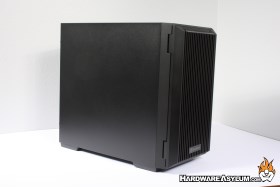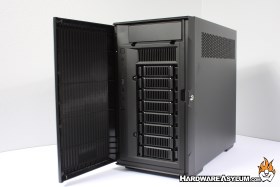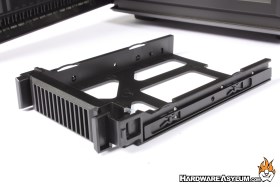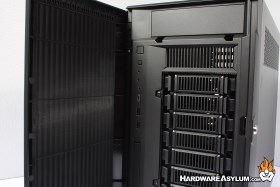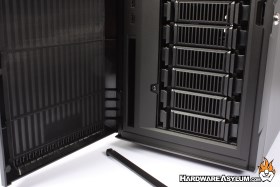SilverStone CS382 Micro-ATX NAS Chassis Review
Author: Dennis GarciaCase Layout and Features
The SilverStone CS382 looks like a regular Mid-tower PC chassis measuring in at 217mm (W) x 405mm (H) x 451mm (D) / 8.54” (W) x 15.94” (H) x 17.76” (D) @ 39.64 Liters. This is about the same size as the Fractal Meshify 2 and rather compact considering what is included.
At the front you will find a vented door with vertical slats. This door is quite stylish, provides ample airflow and can also be secured using the barrel lock found on the side.
Turning the case around you will notice some specific venting built into the side panel. The overall orientation is what I would call “traditional” and “Inverted”
Traditional in that the PSU is located above the motherboard (instead of in a basement) while the inverted nature has everything flipped over putting the PSU at the bottom of the case while the expansion cards are located at the top.

The CS382 supports Mini ITX and Micro ATX motherboards only. You will get an indication of this based on the four expansion slots. Below this you will find a single 120mm exhaust fan, ideally for a CPU AIO.
Opening the door shows you why the SilverStone CS382 is a NAS Chassis and not something designed for gamers. Across the front you will find eight hot-swappable drive trays. These trays are made from plastic and can support 3.5” and 2.5” SAS or SATA based storage devices.
Internally the CS382 supports an additional 3.5” and two 2.5” drive locations.
Along the left side of the front panel you will find the front panel I/O including 2x USB 3.0, 1x USB Type-C, combined analog audio, power and reset. Below the front panel I/O you will find a very narrow external drive bay for a slimline optical drive, slimline SSD adapter or similar bay device. SilverStone sells many of these devices making it a very smart decision to include one.
At the top of the case you will find a vented area above the hot swap bays. Air is typically drawn in across the drives making it important that extra venting be provided. This ensures that some cool air will be entering the chassis which has not already been pre-headed.
Above the hot-swap array is a single external 5.25” drive bay. These bays have gone nearly extinct on most modern gaming cases but, still hold a very real purpose in server machines.
Considering that physical security is very important with servers you will notice that everything is locked away behind the swing door.

